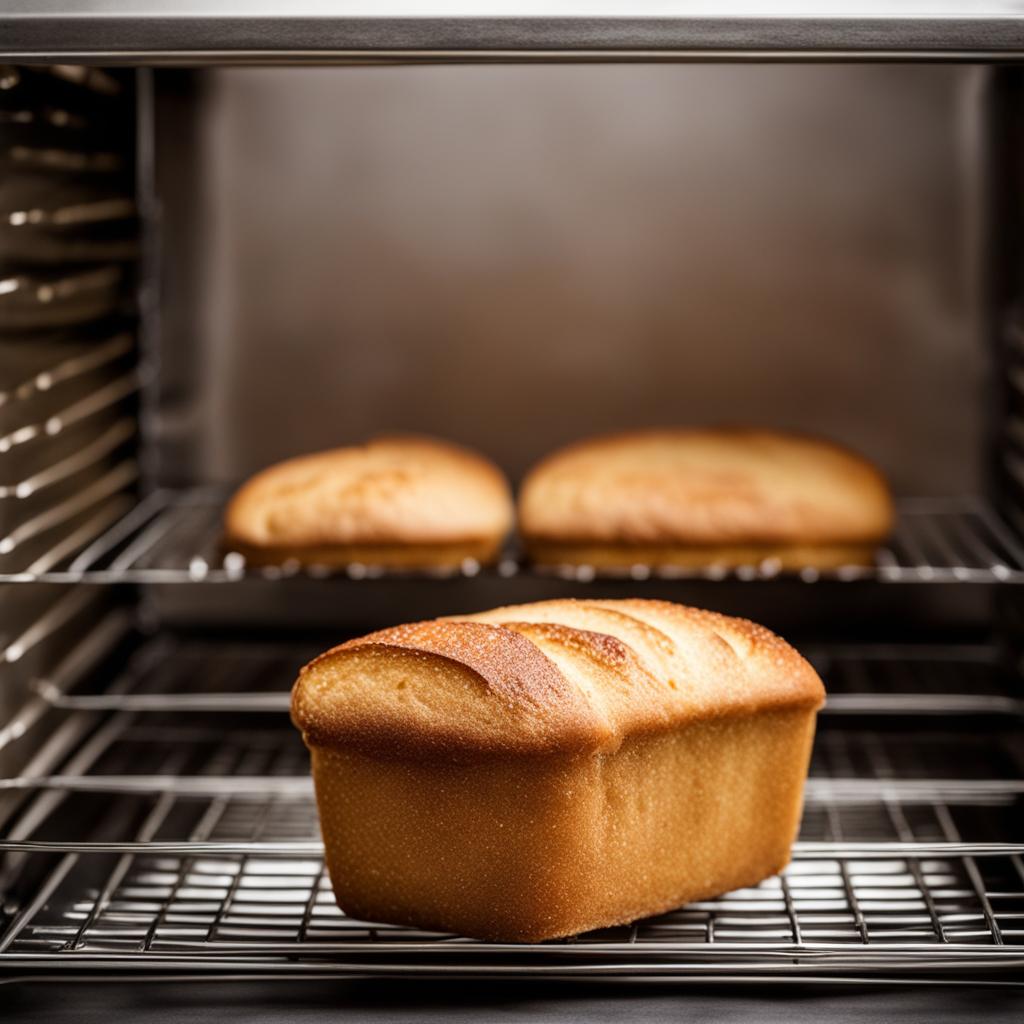Freezing bread is a great way to extend its shelf life and maintain its freshness. By following a few simple tips, you can freeze your bread properly and enjoy it whenever you want.
Whether you’re looking to preserve store-bought bread or homemade loaves, proper storage techniques are essential for maintaining the taste and texture of your frozen bread. In this article, I will share expert tips on how to freeze bread, thaw it, and keep it fresh for longer.
Key Takeaways:
- Properly wrapping and storing bread in the freezer helps maintain its freshness and quality.
- Freeze bread when you know you won’t be able to consume it quickly to prevent it from going stale.
- Tightly wrap each loaf in plastic wrap and place it in a resealable freezer bag to minimize exposure to air.
- Thaw frozen bread at room temperature to retain its original texture.
- You can toast frozen bread directly from the freezer for a quick and easy snack.
When Should You Freeze Bread?
When it comes to freezing bread, timing is everything. It’s best to freeze bread when you know you won’t be able to consume it quickly. Fresh bakery bread, in particular, has a short shelf life and starts to lose moisture, resulting in a decrease in quality. By freezing bread at the right time, you can preserve its freshness and enjoy it later.
If you find yourself with more bread than you can eat within a few days, freezing half of it immediately is a great option. This way, you can ensure that the bread stays fresh and doesn’t go to waste. Freezing bread just before it starts to become stale helps to lock in its moisture and flavor, giving you the opportunity to enjoy it at a later time. So, next time you have extra bread, consider freezing it to extend its shelf life.
“By freezing bread at the right time, you can preserve its freshness and enjoy it later.”
Freezing bread when it’s still fresh and at its best is the key to maintaining its quality. Whether you have a loaf of artisan bread or a bag of sandwich rolls, freezing at the right time will ensure you can enjoy your bread for longer and minimize waste. So, don’t hesitate to reach for the freezer when you have bread that needs to be preserved.
How to Freeze Bread Properly
To properly freeze bread and ensure its freshness, follow these simple steps:
- Start by tightly wrapping each loaf in two layers of plastic wrap. This will help protect the bread from freezer burn and maintain its quality.
- Next, place the wrapped loaf in a resealable freezer bag. Be sure to remove as much air as possible from the bag before sealing it. This will help prevent any moisture from seeping into the bread.
- If you’re freezing sandwich bread, it’s best to slice it before freezing. This way, you won’t have to thaw the whole loaf when you only need a few slices. Plus, slicing it before freezing can help prevent the formation of ice crystals, which can affect the texture of the bread.
By following these steps, you can ensure that your bread stays fresh and delicious even after freezing.
Table: Proper Freezing Techniques
| Step | Procedure |
|---|---|
| 1 | Tightly wrap each loaf in two layers of plastic wrap. |
| 2 | Place the wrapped loaf in a resealable freezer bag, removing as much air as possible. |
| 3 | Slice sandwich bread before freezing to prevent ice crystals and facilitate individual slice thawing. |
“Properly wrapping and storing bread before freezing is crucial to maintain its quality and freshness.” – Source
By using these techniques, you can prolong the shelf life of your bread and have a constant supply of fresh bread whenever you need it. Whether you’re freezing homemade loaves or store-bought bread, the key is to minimize exposure to air and moisture, ensuring that your bread stays as delicious as the day you bought it.
How to Thaw Frozen Bread
Thawing frozen bread is a simple process that requires a little patience. Here are the steps to follow:
- Leave the frozen bread wrapped: When thawing frozen bread, it’s important to keep it wrapped in its plastic or freezer bag. This will help prevent moisture loss and maintain the bread’s texture.
- Thaw at room temperature: Place the wrapped bread on the counter and allow it to thaw at room temperature. Depending on the size of the loaf, this process can take anywhere from 1 to 3 hours.
- Reabsorb moisture: As the bread thaws, it will reabsorb any collected moisture, ensuring that it remains moist and fresh.
If the crust of the bread becomes soft after thawing, you can restore its crunch by heating it in the oven. Simply preheat the oven to 350°F (175°C), place the bread directly on the oven rack, and bake for 5-10 minutes until the crust becomes crispy again.
Tip: Thawed bread can be stored at room temperature for up to 2-3 days. If you don’t plan on using the entire loaf, you can slice it and freeze the individual slices for later use.
Thawing Bread in a Hurry
If you’re in a hurry and need to thaw bread quickly, you can use the microwave. Here’s how:
- Remove the plastic wrap from the bread.
- Place the bread on a microwave-safe plate and microwave on low power for 10-15 seconds at a time. Be careful not to overheat the bread as it can become tough or rubbery.
- Check the bread after each interval until it reaches the desired level of thawing.
Thawing bread in the microwave is a convenient option, but it can affect the texture of the bread and make it slightly chewier. It’s best to use this method only when you need to thaw a small portion of bread quickly.
How to Heat Frozen Bread
When it comes to enjoying frozen bread, there are a few simple methods you can use to heat it up and savor its deliciousness. Whether you want to have a warm slice for breakfast or toast a bagel for a quick snack, these techniques will ensure your frozen bread is perfectly heated and ready to enjoy.
Toasting from the Freezer: One of the easiest ways to heat frozen bread is to toast it directly from the freezer. Simply place your slices in the toaster and adjust the toasting time to account for the colder temperature of the bread. This method works well for both sandwich bread and bagels, giving you a crispy, warm result without the need for thawing.
Reheating in the Oven: If you prefer a more oven-baked taste and texture, you can heat your frozen bread in the oven. Preheat your oven to 350°F (175°C), then place the frozen bread on a baking sheet. Bake for 10-15 minutes or until the bread is heated through and the crust becomes crispy. This method is especially great for artisan bread or baguettes.
Creating a Warm Sandwich: If you have frozen bread and want to make a sandwich, you can simply use the bread straight from the freezer. Layer your desired ingredients between the frozen slices and let the natural warmth of the fillings thaw and heat the bread as you enjoy your delicious creation.
Table: Comparing Heating Methods for Frozen Bread
| Heating Method | Advantages | Disadvantages |
|---|---|---|
| Toasting from the Freezer | – Quick and convenient – Retains the bread’s texture – Suitable for sliced bread and bagels |
– May not give a fully oven-baked taste |
| Reheating in the Oven | – Provides a more oven-baked taste and texture – Great for artisan bread or baguettes |
– Takes longer than toasting – Requires preheating the oven |
| Creating a Warm Sandwich | – No need for thawing – Allows for customized fillings – Natural warmth from the fillings heats the bread |
– Limited to sandwich preparation |
“I love the convenience of toasting frozen bread straight from the freezer. It’s a quick and easy way to enjoy a warm and delicious slice. Plus, the toasting process brings out the flavors and adds a subtle crunch to the bread.” – Bread Lover
Whether you choose to toast, bake, or create a warm sandwich, these methods will help you heat your frozen bread to perfection. Experiment with different techniques to find your favorite way to enjoy the warmth and comfort of fresh bread even when it’s straight from the freezer.

How Long Can You Freeze Bread?
When it comes to freezing bread, it’s important to understand how long you can store it without compromising its quality. While freezing can extend the shelf life of bread, it’s not a magic solution. The freezer storage time may vary depending on the bread’s moisture content and how often it is taken in and out of the freezer.
To give you a general guideline, bread can be stored in the freezer for up to three months without a significant loss in quality or texture. However, it’s worth noting that the bread may become slightly drier over time. To maintain its freshness, it’s recommended to consume it within the first month of freezing.
It’s important to properly store the bread to minimize the risk of freezer burn or flavor deterioration. Tightly wrap the bread in plastic wrap to create a barrier against moisture and air. Then, place the wrapped loaf in a resealable freezer bag, squeezing out as much air as possible before sealing it. Label the bag with the date of freezing to keep track of its storage time.
| Freezer Storage Time | Quality |
|---|---|
| Up to 1 month | Excellent |
| 1-2 months | Good |
| 2-3 months | Adequate |
Remember that these are general guidelines, and the best way to determine if your frozen bread is still good to eat is to rely on your senses. If the bread looks and smells fine, and there are no signs of freezer burn or mold, it should be safe to enjoy.
By understanding the recommended freezer storage time and using proper storage techniques, you can make the most of your frozen bread and ensure that it stays fresh and delicious for as long as possible.
Tips for Freezing Homemade Bread
Freezing homemade bread is a convenient way to preserve its freshness and have it readily available whenever you need it. By following a few simple hacks, you can ensure that your homemade bread stays delicious even after it’s been frozen.
1. Allow the bread to cool completely: Before freezing your homemade bread, make sure it has cooled down completely. This will prevent any condensation from forming inside the packaging, which can lead to freezer burn and affect the bread’s texture.
2. Wrap it tightly: To keep your homemade bread fresh in the freezer, wrap it tightly in plastic wrap. This will help seal in the moisture and prevent any freezer odors from seeping into the bread. For extra protection, you can also wrap the bread in foil or freezer paper.
3. Label and date your loaves: It’s important to label your frozen homemade bread with the date it was frozen. This way, you can keep track of how long it has been stored in the freezer and ensure that you use the oldest loaves first.
4. Freeze for up to six months: Homemade bread can be stored in the freezer for up to six months without a significant decrease in quality. However, for the best taste and texture, it’s recommended to consume the bread within the first three months of freezing.
By following these bread storage hacks, you can enjoy the taste of homemade bread at any time. Whether you’re making extra loaves for future use or trying to avoid waste, freezing homemade bread is an easy and effective way to extend its shelf life.
| Hacks for Freezing Homemade Bread |
|---|
| Allow the bread to cool completely before freezing |
| Wrap the bread tightly in plastic wrap or foil |
| Label and date your loaves for easy identification |
| Freeze for up to six months for optimal freshness |
Tips for Freezing Store-Bought Bread
Freezing store-bought bread is a convenient way to extend its freshness and ensure you always have a ready supply of your favorite loaf on hand. By following a few simple hacks, you can maintain the quality of store-bought bread and enjoy it whenever you desire.
Proper Storage Techniques
When freezing store-bought bread, you can start by simply placing the entire loaf in the freezer if you plan to consume it within a month. However, for longer storage, it’s recommended to take a few extra steps to protect the bread from freezer burn. Begin by tightly wrapping the loaf in plastic wrap, ensuring it is completely sealed. Then, further secure the wrapped loaf by wrapping it in foil or freezer paper. This additional layer of protection will help preserve the bread’s texture and flavor during freezing.
Labeling and Dating
To keep track of your frozen bread supply, it’s essential to label each loaf with the date of freezing. This way, you’ll know how long it has been in the freezer and can prioritize consumption accordingly. Use a permanent marker or adhesive label to clearly mark the date on the wrapping material. Additionally, if you have different types of bread in the freezer, labeling can help you easily identify and select the desired loaf when needed.
Optimal Freezing Time
Store-bought bread can generally be frozen for up to six months without a significant loss in quality. However, it’s important to note that the precise freezing time may vary depending on the specific type of bread and the frequency of freezer access. To ensure the best taste and texture, try to consume the frozen bread within the first few months of freezing. Remember, always trust your senses – if the bread appears discolored or develops an off odor, it’s best to discard it.
Summary
Freezing store-bought bread is a viable option for preserving its quality and ensuring a constant supply. By properly wrapping and storing the loaf, labeling with the freezing date, and consuming within a reasonable time frame, you can enjoy store-bought bread that tastes just as fresh as the day you bought it.

How to Defrost Frozen Bread
When it comes to defrosting frozen bread, there are a few simple techniques you can use to ensure that your bread retains its freshness and flavor. Here are some defrosting tips and techniques to help you enjoy your frozen bread:
- Room Temperature Thawing: The easiest way to defrost frozen bread is to leave it at room temperature until it thaws completely. Simply take the bread out of the freezer, remove any packaging, and place it on a countertop or cutting board. Depending on the size of the loaf, it may take anywhere from 1 to 4 hours for the bread to thaw. Once thawed, you can refresh the bread by reheating it in a preheated oven for a few minutes.
- Toasting from Frozen: If you’re in a hurry or only need a few slices of bread, you can toast them directly from the freezer. Place the frozen slices in a toaster or toaster oven and adjust the toasting time to accommodate the colder temperature. Toasting frozen bread will yield a crispy texture on the outside while keeping the inside soft and fluffy.
These defrosting techniques are convenient and ensure that your bread is ready to eat in no time. Remember that once bread is thawed, it is best consumed within a day or two for optimal freshness.
“I love using the room temperature thawing method for frozen bread. It allows the bread to gradually defrost without compromising its texture and taste.” – Bread enthusiast
Tips for Defrosting Bread:
- Plan ahead and thaw only the amount of bread you need to minimize waste.
- Never use a microwave to defrost bread, as it can make the bread rubbery and unevenly thawed.
- If you have a large loaf of bread, consider slicing it before freezing. This makes it easier to thaw and use smaller portions as needed.
Table: Thawing Methods for Frozen Bread
| Method | Time | Benefits |
|---|---|---|
| Room Temperature Thawing | 1-4 hours | Preserves the texture and taste of the bread |
| Toasting from Frozen | Varies based on toasting time | Offers a quick and crispy alternative for small portions |
Using Stale Bread
If you find yourself with stale bread, don’t despair! Stale bread can actually be repurposed into delicious dishes that will have you savoring every bite. Whether it’s bread pudding, breadcrumbs, or croutons, there are plenty of ways to transform stale bread into something extraordinary.
One classic way to utilize stale bread is by making bread pudding. This comforting dessert is made by soaking the bread in a custard mixture and baking it to perfection. The result is a moist and flavorful treat that can be enjoyed on its own or topped with your favorite sauce or ice cream. The versatility of bread pudding allows you to get creative with flavors and add-ins, making it a delightful dessert for any occasion.
Another popular use for stale bread is to turn it into breadcrumbs. Simply toast or bake the bread until it becomes crispy and golden, then pulse it in a food processor until you achieve the desired texture. Breadcrumbs can be used to add a crunchy coating to fried foods, as a topping for casseroles, or as a binder in meatballs and stuffing. They’re a pantry staple that can elevate any dish.
Lastly, stale bread is perfect for making homemade croutons. Cut the bread into cubes, toss them with olive oil or melted butter, and season with herbs and spices. Then, bake them until they’re crispy and golden. Sprinkle these flavorful croutons onto salads, soups, or even use them as a crunchy topping for mac and cheese. They add texture and flavor to any dish.
Bread Transformation Ideas:
- Bread pudding – a delicious dessert made with stale bread soaked in a custard mixture and baked to perfection.
- Breadcrumbs – crispy and golden, they can be used as a coating, topping, or binder in various recipes.
- Croutons – seasoned and baked until crispy, they add a delightful crunch to salads, soups, and more.
So, the next time you have stale bread on hand, don’t toss it away. Instead, get creative in the kitchen and transform it into mouthwatering dishes that will surprise and delight your taste buds. Whether it’s bread pudding, breadcrumbs, or croutons, stale bread can be the star ingredient in a variety of culinary creations.
Maintaining Bread Quality in the Freezer
When it comes to freezing bread, proper preservation methods are crucial to ensure the bread maintains its quality and freshness. By following a few freezer tips, you can enjoy delicious bread even after it has been frozen.
Minimize Exposure to Air
One of the key factors in maintaining bread quality in the freezer is minimizing exposure to air. Oxygen can cause freezer burn and result in a decrease in texture and taste. To prevent this, tightly wrap the bread in plastic wrap, making sure there are no gaps for air to seep in. Place the wrapped bread in a resealable freezer bag and squeeze out as much air as possible before sealing it.
Prevent Freezer Burn
Freezer burn occurs when moisture in the bread evaporates and then re-condenses into ice crystals. These ice crystals can cause the bread to become dry and develop a stale taste. To prevent freezer burn, it’s important to protect the bread from fluctuations in temperature. Ensure your freezer is set to a consistent temperature and avoid frequently opening and closing the freezer door.
Proper wrapping and storage techniques will help preserve the taste and texture of your bread, allowing you to enjoy it as if it were fresh.
By following these freezer tips, you can maintain the quality of your bread in the freezer, ensuring that it stays fresh and delicious until you’re ready to enjoy it.
| Freezer Tips | Benefits |
|---|---|
| 1. Tightly wrap bread in plastic wrap before placing it in a freezer bag. | – Minimizes exposure to air – Prevents freezer burn |
| 2. Squeeze out as much air as possible from the freezer bag before sealing it. | – Reduces the risk of freezer burn |
| 3. Store bread in the coldest part of the freezer. | – Maintains a consistent temperature |
| 4. Avoid frequently opening and closing the freezer door. | – Prevents temperature fluctuations |
Remember, proper bread freezer techniques can help you preserve the taste and texture of your bread, allowing you to enjoy it whenever you desire.
Freezing Different Types of Bread
When it comes to freezing bread, different types of bread can vary in their freezing techniques and results. While most breads can be frozen successfully, it’s important to consider the specific characteristics of each type to ensure the best outcome.
Freezing Techniques for Different Bread Types
Simple breads like sourdough, baguettes, and plain sandwich bread freeze exceptionally well. Their minimal ingredient list of flour, salt, and water makes them less prone to texture and flavor changes during freezing. These types of bread can be frozen as whole loaves or sliced, depending on your preference.
However, breads that contain dairy or eggs may experience a decrease in quality after freezing. This includes rich and delicate breads like brioche or challah. These breads are better suited for dishes like bread pudding or stuffing, where they can be transformed into delicious, flavorful creations.
Freezing Tips for Optimal Results
To ensure the best results when freezing different types of bread, consider the following tips:
- Wrap the bread tightly in plastic wrap to prevent freezer burn and maintain its moisture.
- If the bread is sliced, separate the slices with parchment paper to make it easier to thaw and use individual portions.
- Label the bread with the date of freezing to keep track of its freshness.
- Store the bread in a freezer-safe bag or container to protect it from absorbing unwanted flavors or odors.
By following these freezing tips and considering the characteristics of each bread type, you can ensure that your frozen bread remains delicious and ready to enjoy whenever you need it.
Conclusion
Freezing bread can help you reduce waste and always have fresh bread on hand. By following these tips, you can properly freeze and thaw bread to maintain its freshness and quality. Whether you’re storing store-bought bread or homemade loaves, proper wrapping and storage techniques will ensure your frozen bread tastes as good as fresh.
According to First source, freezing bread is a great way to extend its shelf life and maintain its freshness. Tightly wrapping each loaf in two layers of plastic wrap and placing it in a resealable freezer bag will prevent freezer burn and preserve the taste and texture of the bread.
As mentioned in Second source, it is best to freeze bread when you know you won’t be able to consume it quickly. Fresh bakery bread has a short shelf life, and freezing it allows you to enjoy it later without any loss in quality. Additionally, bread can be stored in the freezer for up to three months without a significant decrease in freshness.
If you have stale bread, don’t throw it away! As stated in Third source, stale bread is perfect for making delicious French toast, bread pudding, breadcrumbs, or croutons. Just make sure the bread is only a day or two past its prime and free from any mold or strange smells.
FAQ
How do I freeze bread properly?
To freeze bread properly, tightly wrap each loaf in two layers of plastic wrap and place it in a resealable freezer bag, removing as much air as possible. For sandwich bread, slice it before freezing to prevent freezer burn and maintain its quality.
When should I freeze bread?
It is best to freeze bread when you know you won’t be able to consume it quickly. Fresh bakery bread has a short shelf life and starts to lose moisture, resulting in a decrease in quality. If you have more bread than you can eat, freeze half of it immediately to enjoy later.
How do I thaw frozen bread?
When thawing frozen bread, leave it wrapped and thaw it on the counter. As it reaches room temperature, the bread will reabsorb any collected moisture and regain its original texture. If the crust becomes soft after thawing, you can restore its crunch by heating it in the oven.
How do I heat frozen bread?
To heat frozen bread, you can toast it directly from the freezer. Adjust the toasting time to accommodate the colder temperature. For bagels, slice them before freezing and heat them from frozen. This allows you to enjoy your frozen bread without thawing it first.
How long can I freeze bread?
Bread can be stored in the freezer for up to three months without a significant loss in quality or texture. However, the exact time may vary depending on the bread’s moisture content and how often it is taken in and out of the freezer.
How do I freeze homemade bread?
When freezing homemade bread, make sure it is completely cooled before wrapping it tightly in plastic wrap. For extra protection, you can also wrap it in foil or freezer paper. Label the loaf with the date and freeze it for up to six months.
How do I freeze store-bought bread?
Store-bought bread can be frozen directly in its original packaging. If you plan to use the bread within a month, there is no need to do anything special. For longer storage, wrap the loaf tightly in plastic wrap and then in foil or freezer paper. Label it with the date and freeze for up to six months.
How do I defrost frozen bread?
To defrost frozen bread, simply take it out of the freezer and let it thaw at room temperature until it is no longer ice-cold. You can then refresh the bread by reheating it in a preheated oven. If you only need a few slices, you can toast them directly from the freezer.
What can I do with stale bread?
If you have stale bread, there’s no need to throw it away. Stale bread is perfect for making delicious French toast, bread pudding, breadcrumbs, or croutons. Just make sure the bread is only a day or two past its prime and doesn’t have any mold or strange smells.
How can I maintain the quality of bread in the freezer?
To maintain the quality of bread in the freezer, it’s important to minimize exposure to air and prevent freezer burn. Wrap the bread tightly in plastic wrap and place it in a resealable freezer bag, removing as much air as possible. This will help preserve the taste and texture of the bread.
Can I freeze different types of bread?
Different types of bread freeze well, but some may be more suitable for specific preparations. Sourdough and simple breads made with flour, salt, and water freeze exceptionally well, while breads containing dairy and eggs may experience a decrease in quality after freezing. These breads are better used for dishes like bread pudding or stuffing.
Source Links
- https://www.allrecipes.com/article/how-to-freeze-bread/
- https://www.foodnetwork.com/how-to/packages/help-around-the-kitchen/how-to-freeze-bread
- https://www.marthastewart.com/271861/good-thing-how-to-freeze-bread
Related Recipes:
 How to Store Bread to Preserve Its Freshness
How to Store Bread to Preserve Its Freshness
 Bread Storage: How Long Does Bread Last in the Fridge?
Bread Storage: How Long Does Bread Last in the Fridge?
 How to Freeze Bananas? (Perfect Step-By-Step Guide)
How to Freeze Bananas? (Perfect Step-By-Step Guide)
 How to Recognize Stale Bread
How to Recognize Stale Bread
 Can You Freeze Stuffing? How to Preserve the Holiday Dish
Can You Freeze Stuffing? How to Preserve the Holiday Dish
 How to Freeze Corn: Tips for Freshness
How to Freeze Corn: Tips for Freshness
 Can You Freeze Garlic? Here’s How to Do It Right.
Can You Freeze Garlic? Here’s How to Do It Right.
 How to Make Homemade Croutons? (Perfect Every Time!)
How to Make Homemade Croutons? (Perfect Every Time!)








